Frequently Asked Questions & Suggestions
— I have lost the wedge insert. Where can I get another one?
Go to a photo store and ask for the wedge insert for a Manfrotto super clamp. This will fit your clamp perfectly. _______________________________________________________
— Do you sell parts for the Best Brella?
Yes, we will sell you parts providing you already own a Best Brella. The web site isn’t set up to sell parts, so you’ll have to send an inquiry to info@bestbrella.com. We’ll respond with the part price and payment arrangements. ________________________________________________________
— I have opened the clamp all the way up and now I can’t close it. Can it be fixed?
See the video in the photos & video section. Don’t worry, the fix is simple, but a bit hard to describe. The clamp has a round metal washer that should make contact with the curved part of the clamp’s exterior. If you open it up too far, it slips off this area. To fix it, simply squeeze closed (and hold) the jaws of the clamp with your left hand while turning the lever closed with your right hand. This should restore the clamp to the right configuration.
________________________________________________________
—Why Using the Best Brella Can Improve Your Painting

Your silver Best Brella will keep you over 10 degrees cooler and more comfortable while painting. It will also shield you from harmful UV light. But did you realize that using an umbrella can actually improve your paintings? Consider the following:
See More Color
When painting without an umbrella, your pupils close down in the bright outdoor light. This diminishes your ability to see color. In the shade of an umbrella, your pupils will dilate more and it will be easier to see subtle colors.
Paintings Look Good Indoors
Your painting may look just right under outdoor lighting, which can be ten times as bright as indoor light; but most of us don’t hang our paintings outdoors. When displayed indoors, that same painting will seem much darker than you remembered. By choosing or mixing your colors in the shade of an umbrella, you greatly improve your chances of the the painting “reading right” when hung in indoor light.
|
Illuminance
|
Conditions
|
|
120,000 lux |
Brightest sunlight |
| 110,000 lux | Bright Sunlight |
| 20,000 lux | Shade illuminated by entire clear blue sky, midday |
| 10,000 – 25,000 lux | Typical overcast day, midday |
| 10,000 lux | Very bright florescent lighting |
| 400 lux | Sunrise or sunset on a clear day (ambient illumination) |
| 100-300 lux | Normal indoor lighting |
| 0.25 lux | Full Moon on a clear night |
Easier to Mix and Choose Colors
Umbrellas eliminate reflection and glare on your painting and palette and help you to see what your are painting. This is especially true for oil paints, which are highly reflective.
Celebrated Plein Air Painters Used Umbrellas
For more on this topic (with great photos), please read Eric Merrell’s essay The Artist’s Umbrella .
________________________________________________________
—GREAT IDEA — USE EXTENSION POLE AS A MAHL STICK
Need a mahl stick to paint some detail? Just use the second extension pole as your mahl stick. The plastic reinforcing sleeve will keep the pole from touching the surface of your painting, just hook the edge over the top of your easel. You can then rest your hand on the pole for more control (photo coming soon).
________________________________________________________
— Do you sell to international customers?
Yes, just order as usual and Amazon will handle the currency exchange and charge you for international shipping. We ship Priority International which will take seven to ten days to arrive at your customs. The time it takes to clear customs and be delivered locally must be added to the 7-10 day estimate.
________________________________________________________
— Another GREAT IDEA — Use your umbrella pole to hold a roll of paper towels.
Just slip the umbrella shaft through the roll of paper towels before your insert it into the rotating arm. Don’t forget to tighten the white plastic set screw before your slide the roll over that area. Also, you might want to flatten the roll a bit so it doesn’t rotate in the wind.
______________________________________________________
— Having trouble fitting the clamp and arm into the bag?.
Before you insert the clamp with the attached arm into the bag, be sure the arm is vertical and aligned with the edge of the clamp. Turn the clamp knob (lever) so it is pointing up (away from the clamp). The assembly then slips easily into the case(photo coming soon). Of course you could always disconnect the arm from the clamp, but that leaves more to do the next time you set up.
____________________________________
— The brass screw at the end of the pole seems to be loose and rotating. Can this be fixed? It’s difficult to unscrew the pole from the umbrella.
To unscrew the pole from the umbrella shaft, pull in opposite directions while unscrewing. This should work even if the brass insert (screw) is loose.
You can fix this problem with some penetrating or wicking grade threadlocker. You must use these specific products — super glue won’t penetrate into that very small opening, but these products will.
Loctite Threadlocker 290 Penetrating Wicking Grade (Green) or
Permatex Threadlocker Penetrating Grade


You’re most likely to find these products in an auto parts store. Hardware stores have “threadlockers” but seldom stock the “wicking” or “penetrating” grade that you need for this application. You can also order these products from Amazon.
This thin liquid has to sink into that hairline crack between the black pole and the rim of the pole insert. After applying a small drop, rotate the pole and you’ll see the liquid disappear into the thin crack. It should secure the insert within the pole within 10 minuites, but you need to wait 24 hours before putting it under any stress, such as using it with your umbrella. Do not apply this to the insert threads, just to the thin brass rim where the pole meets the insert.

If this doesn’t work, you can always buy a replacement pole from the “Replacement Parts” section of this website. Artists have been using the Best Brella in windy conditions that normal umbrellas cannot endure, but over time, the buffeting of the winds may loosen this insert.
— How to use the Ruler of Thirds that came with your order.

- View your subject or a photo of your subject in a grid of thirds (see below for how to do this).
- Grid your canvas into thirds using the Ruler of Thirds.
- Draw your subject onto the canvas. Having both the subject and the canvas in the same 1/3 grid will make this so much easier.
Outdoors:
Divide “picture plane” of your subject into thirds. Outdoors this can be done with a viewfinder that is marked off in thirds and is the same proportional dimensions as your canvas. For instance a 3” by 4” viewfinder (ratio of 3:4) will work for any canvas with the same ratio: 6 x 8; 9 x 12; or 12 x 16. A viewfinder with the ratio of 2:3 will work for canvases measuring 4×6, 8×12, etc. A view finder with a ratio of 1:1 will work a square canvas of any size. I like to use a viewfinder called “Compose-It-Grids” as it has six viewfinders of various ratios on one see-through acrylic sheet, and all of them are divided into thirds. Choose the grid that matches the proportions of your canvas, then look through the view finder to select your composition and you’ll see your subject divided into thirds.
or
Use Your Camera Take a photo of your subject. With newer cell phones you can edit your photo on the phone. Select the “crop” feature and you should see your photo with a 1/3 grid superimposed on it. You can also import your photo into these great cell phone and computer apps: AccuDraw, AccuView, or Grid Drawing Assistant (free). Each of these will grid any photo on your camera. It can also display your photo in black and white, which helps you to see the value structure of your subject. These apps do not permanently alter your original photo.
Gird your canvas This is where you’ll save lots of time drawing. Use the Ruler of Thirds to divide your canvas into thirds. If your canvas is 11 x 14, find the 11” mark on the ruler. That distance, from the left side of the ruler to the 11” mark is exactly 1/3 of 11”. Mark off that distance on both of the 11” sides of your canvas. Next, find the 14” mark on the ruler. The distance from the left side of the ruler to the 14” mark is exactly 1/3 of 14”. Mark this distance off on the two 14” edges of your canvas. Connect the marks and your canvas is divided into thirds. No inconvenient measuring or having to divide 11” by three to figure out how many inches 1/3 of 11 is. The Ruler of Thirds does this for you.
Draw your compostion: Looking through your gridded viewfinder, or looking at your gridded photo, to transpose what you see, segment by segment, to your gridded canvas. Your drawing will be in correct proportion and it will fill your canvas. It’s so much easier and quicker to draw this way.
Which is best? The Semi Translucent White Umbrella or the Silver Lined in Black?
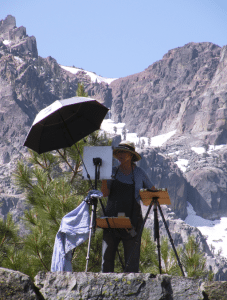
Silver/Black Best Brella Recommended for High Altitudes
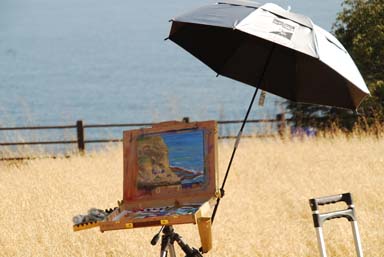
Silver Best Brella with Black Interior
The silver exterior with black interior reflects more UV and is better for those concerned about skin cancer. I think it also keeps you a bit cooler, but it is harder to see your paint colors. Some artists recommend only a black lined umbrella to keep the pupils open wider so that you can see more of the color in the landscape when looking out from under the umbrella; however, it’s harder to judge colors on your palette. If you’re painting in the bright light and heat of the Southwest, or at high altitudes, I’d recommend the silver/black.
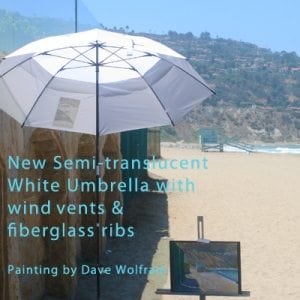 The White Semi-Translucent White Best Brella has a white nylon upper canopy that lets in as much light as the Soleil French Easel umbrella or a photo umbrella, but the lower canopy has a double layer of fabric that lets less light show through. You can
The White Semi-Translucent White Best Brella has a white nylon upper canopy that lets in as much light as the Soleil French Easel umbrella or a photo umbrella, but the lower canopy has a double layer of fabric that lets less light show through. You can
see that in the photo to the left. I’ve tested it and the transition from translucent to semi-translucent (where the two canopies meet) does not leave any shadows or change in value on the painting or palette. I think this is because the light refracts (bounces around) so much within the white interior of the umbrella. If you’re painting foggy coastal or dappled light forest scene, I’d recommend the white.
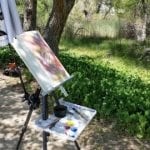
Dappled Light without Umbrella
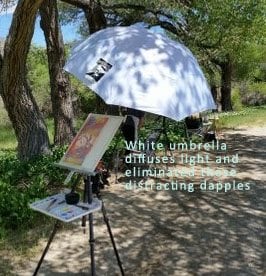
Best Brella Eliminates Dapples on Painting
The white Best Brella eliminates distracting dappled light. When painting in a forest with dappled light I find the dappled light on my painting very distracting and difficult to deal with. If put up my silver umbrella and the shade is so dark, given that I’m already in 90% tree shade, that it was hard to see what I was doing. The white umbrella was the perfect solution. The same is true for cloudy, foggy days, where there is still a lot of reflected light.
The white umbrella provides more light on your palette and painting, which some like. It’s really a matter of personal preference. Pastel painters may find picking the right pastel color easier with a white umbrella. If you find that when painting with a white umbrella, your paintings turn out too “dark” when viewed indoors, then you should switch to black.
Ultimately, this is a personal choice. It’s nice to have both colors and use them under certain conditions. You could always buy Kit C which, for an extra $30, includes one of each color. For instance, eyes, even though it’s a cloudy day.
Copyright 2009, BestBrella.com All rights reserved.
